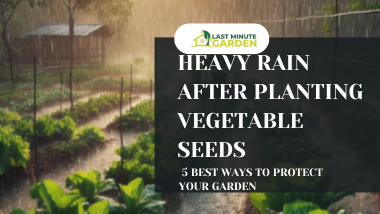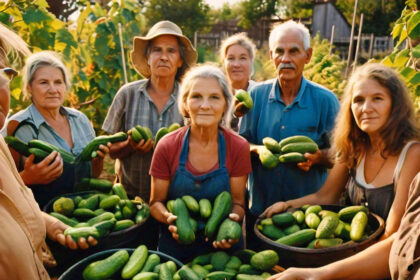Protecting your garden from heavy rain after planting vegetable seeds is essential for a thriving crop.
A successful harvest depends on preparing your garden for heavy rain after you plant vegetable seeds. A lot of rain can damage early plant growth by compacting soil, washing away seeds, and creating soggy conditions.
You may give your seedlings the greatest start possible and shield your vegetable garden from these probable setbacks by taking the appropriate safeguards.
In this guide, we will explore the five best ways to protect your garden from heavy rain after planting vegetable or flower seeds. From proper drainage systems to strategic mulching techniques, these methods will help you maintain a healthy and thriving garden, even in the face of unpredictable weather.
1. Improve Garden Drainage
Effective drainage is the foundation of protecting your garden from heavy rain after planting vegetable seeds. When water is unable to drain properly, it can pool around your seeds’ germination, leading to rot, soil erosion, and loss of nutrients. Here are some ways to improve garden drainage:
- Raised Garden Beds: Raised beds elevate the planting area, allowing excess water to drain away more easily. By raising your vegetable seeds above ground level, you can avoid soil from excess water accumulation around the seeds during a downpour. Raised beds are particularly useful in areas with heavy clay soil or poor natural drainage.
- French Drains: Installing a French drain can direct water away from your garden. This underground drainage system consists of a gravel-filled trench with a perforated pipe that redirects water to a different part of your yard, reducing the risk of waterlogged soil around your vegetable seeds.
- Slope the Garden Surface: Slope your garden slightly to allow water to flow away from the planted areas. A gentle slope ensures that rainwater does not sit in one place for too long, reducing the chance of seed displacement and soil erosion.
2. Apply a Protective Mulch Layer
Mulching is an effective way to shield your garden from the adverse effects of heavy rain after planting vegetable seeds. A well-applied mulch layer helps absorb excess water, preventing soil erosion and seed displacement. Here’s how you can use mulch to protect your seeds:
- Organic Mulch: Shredded leaves, grass clippings, straw, or hay make excellent organic mulch. These materials absorb rainwater and help regulate soil moisture levels. They also protect your seeds from being ruined by rainstorms.
- Inorganic Mulch: Materials like landscape fabric or gravel can also serve as protective barriers. Inorganic mulch helps retain soil structure while allowing excess water to drain away. While it doesn’t offer the nutrient benefits of organic mulch, it is particularly useful in high-rainfall regions.
- Mulch Depth: When mulching, ensure that the layer is not too thick, as this can prevent water from reaching the seeds altogether. A depth of 1-2 inches is ideal for protecting without suffocating the newly planted vegetable seeds.
Mulching not only offers protection from heavy rain after planting vegetable seeds but also helps suppress weeds and maintain consistent soil temperature.
3. Use Row Covers and Protective Tunnels
Physical barriers like row covers and low tunnels can be highly effective in protecting your vegetable seeds from heavy rain. These structures shield your garden from direct exposure to rainfall while still allowing air circulation and light to penetrate. Here’s how to use them:
- Row Covers: Lightweight fabric row covers can be placed directly over your planted seeds. The material is breathable, allowing sunlight and air to pass through, but acts as a barrier against rainstorms, preventing soil compaction and erosion.
- Hoop Tunnels: For larger gardens, hoop tunnels made from plastic sheeting or mesh are an excellent way to safeguard young plants from downpours. The ability to tie these tunnels to the ground prevents the moisture from upsetting the soil and seeds while still encouraging growth.
- Temporary Covers: In the event of a forecasted storm, you can also use temporary plastic sheets or tarps to cover your planted areas. Make sure these covers are securely fastened to prevent strong winds from blowing them away.
4. Improve the composition of the soil
The condition of your soil plays a vital role in how well your garden can handle heavy rain after planting vegetable seeds. Loose, well-aerated soil promotes drainage and prevents water from pooling, reducing the risk of seed loss. Here’s how to optimize your soil for rainy conditions:
- Amend with Organic Matter: Adding organic matter such as compost or well-rotted manure improves soil structure, helping it retain moisture without becoming waterlogged. Organic matter also provides essential nutrients that promote healthy seedling growth.
- Aeration: Regularly aerating your soil loosens compacted earth, allowing water to drain more effectively. Aeration tools, such as garden forks or manual aerators, can be used to puncture the soil and improve air pockets and water penetration.
- Sandy Soil Additions: For gardens with heavy clay soil, incorporating sand or perlite can improve drainage by breaking up topsoil particles. This prevents water from pooling around your vegetable seeds after a heavy downpour.
- Maximizing your soil composition ensures that water and nutrients are adequately dispersed throughout the garden, shielding your seeds from the damaging effects of heavy rain after planting.
5. Plan for Raised Pathways and Trenches
In addition to protecting your vegetable seeds directly, you can also manage rainwater by designing your garden layout with raised pathways and trenches. These features help divert water away from planting areas, reducing the risk of flooding. Here’s how to incorporate them:
- Raised Pathways: Slightly elevating the paths between garden rows, you create a natural barrier that keeps water from flowing directly into your planted areas. Raised pathways help prevent erosion and waterlogging, ensuring your vegetable seeds stay in place till the land is dry.
- Trenches: Digging shallow trenches between planting beds can also direct excess water away from the seeds. These trenches act as natural water channels, allowing rainwater to flow into designated areas of the garden where it can drain harmlessly to the bottom.
- Water Collection Systems: Consider incorporating a rainwater collection system to capture runoff from heavy rain. The gathered water can be retained for later use in irrigation, ensuring that your garden benefits from rains without being flooded. Planting weed seeds also regulates the moist soil.
- Integrating raised pathways and trenches into your garden design, you can effectively manage heavy rain after planting vegetable seeds, keeping your soil intact and your plants safe. Planting weed seeds also regulates the moist soil.
Conclusion
Protecting your garden from heavy rain after planting vegetable seeds is crucial for ensuring healthy plant growth. You can protect your newly planted seedlings from the damaging effects of too much water by utilizing raised paths, mulching, row coverings, and soil composition optimization.
Taking these steps ensures that your vegetable seeds remain securely in place, germinate successfully, and thrive, even when heavy rain strikes. With proper preparation, your garden will flourish throughout the growing season, no matter the weather conditions.





